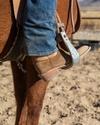
Choosing the perfect pair of cowboy boots – or even a sassy pair of Western booties – isn't just about picking a style that catches your eye. Sure, the design, leather type, shaft height, and color all play a part. But have you ever stopped to consider the heel?
Just like the stars in the Texas sky, there's a whole universe of cowboy boot heel types out there for both men and women. Each one has its unique purpose and style. So, if you've been riding through life without giving much thought to your boot's heel height or type, it's time to saddle up and learn something new. In this guide, we’ll wrangle the six major cowboy boot heels, including those on our western booties, and help you lasso the right one for your lifestyle.

1. Fowler Heels
Ideal for ranch work and everyday wear, Fowler heels are as common as tumbleweeds in a Western movie. They're also one of the oldest, most traditional styles — their inventor, John Fowler, patented Fowler heels way back in 1883. They initially rose to popularity with cowboys and ranchers because the heels' low profile is less likely to get caught in stirrups.
Considered a standard heel at 1-1/8 to 1-1/4" high, you'll see Fowlers both straight and pitched (also called slanted). Pitched heels gently angle backward at the back of the heel, giving them a distinct look. Their low height and decent traction in dirt and mud make Fowler heels especially comfortable, which is why they're considered one of the best walking-heel cowboy boots. Technically, straight-cut Fowler cowboy boot heels are the best for walking because they're the most stable, but pitched heels aren't far behind.
One other minor difference between the cuts of the heel is that slanted Fowlers are more commonly seen on dressier boots — AKA "church boots," whereas casual boots tend to have straight heels. However, either style can easily be worn with a variety of outfits.
2. Roper Heels
As the name suggests, the Roper heel was designed specifically for rodeo cowboys who competed in roping events. They're extremely similar to Fowler heels, available in both straight and pitched styles. However, there are some key differences: Roper boots have a slightly shorter heel at 1", and it's more sharply angled, better for gripping stirrups (and jumping out of them!) when riding.
The low, almost flat heel offers excellent stability, one of the most important factors when working with large animals, especially in a fast-paced environment. For the same reason, the Roper heel is also widely considered one of the best riding-heel cowboy boots.


3. Walking Heels
These western boots are literally made for walkin'. With a slightly taller heel (1-3/8") than Fowler or Roper boots, walking heels are the most comfortable for continuous wear. The wide, flat heel offers superior stability and support, so this is a great option for a work boot, for someone who loves Western fashion and prefers to wear boots most of the time, or of course, for anyone who does a lot of walking.
Walking cowboy boot heels are some of the most common that you'll see offered in rubber as an even more comfortable alternative to traditional wood.
4. Cowboy Heels
As you may have guessed, cowboy heel boots are the most traditional and quintessentially Western. Designed primarily as riding boots, the angled, taller 1-1/2 to 1-3/8" heel provides a strong grip and stability in the stirrups, helping to prevent the rider's foot from slipping out. On the flip side, while the bit of added height is a nice perk, it makes walking around or even standing for extended periods of time fairly uncomfortable.
This heel style is also the most commonly seen on fashion boots, particularly for women. The slant and height of the heel set the perfect base for added embellishments.


5. Riding Heels
Quite similar to cowboy boot heels, riding heels are 2" tall and have a very distinct slant. Aside from being eye-catching, that slant serves a purely functional purpose. The angled edge of the heel helps prevent the rider's foot from slipping off or sliding forward in the stirrup, providing unmatched stability. You wouldn't want to spend hours walking in riding heels, but they're supportive and comfortable enough for long hours in the saddle.
6. Fashion Heels
At the complete opposite end of the spectrum from riding cowboy boot heels, fashion heels are entirely about looks. These types of boots, which often come in bold colors or exotic leather, have narrow, slanted, 3-4" heels. As the tallest cowboy boot heel types, these are almost always seen on cowgirl boots. While they make fabulous statement boots, they're not particularly comfortable for working the land, riding horses, or walking long distances. Wear these stylish boots to add a Western touch to any outfit, from jeans and a t-shirt to a Coastal Cowgirl.
Before buying a pair of fashion heels, keep in mind that these types of boots often have to be broken in before wearing them (comfortably, anyway!) for long periods of time.

Choosing the Best Cowboy Boot Heels
Well, now that y'all are basically experts on cowboy boot heel types, the next step is picking out a new pair of boots. To decide on the right heel type and height, think about what you'll wear your boots for most often and where you're going to wear them. Remember, if you're more likely to be working the ranch or riding the range in your boots, you'll want to stick to a lower heel.
But if you're looking for a show-stopping pair to paint the town red, the sky's the limit! Mosey on over to Tecovas to find the perfect pair to match your lifestyle and needs, and be sure to check out our other Western wear.